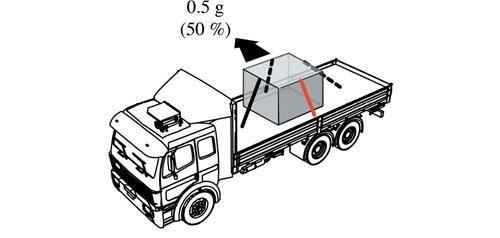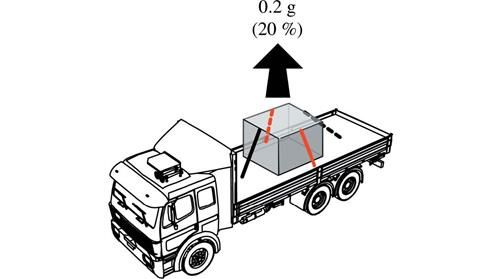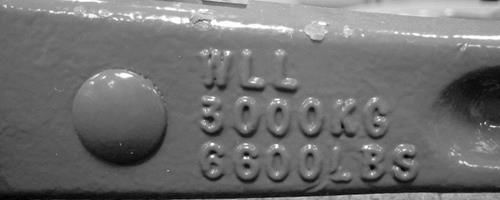Review Questions - Click On The Picture To Begin...

- 5,000 lbs
- 2,500 lbs
- 6,000 lbs
- 10,000 lbs
Quote From The CDL Manual:
Note: The minimum WLL requirement for the securement system is 50%. More tiedown capacity should be used if you need to secure an article against any movement.
- A rail along the side of a vehicle that protects the side of the vehicle from impacts.
- A vertical barrier placed directly behind the cab of a tractor to protect the cab in the event cargo should shift forward.
- A device placed on the exposed edge of an article to distribute tiedown forces over a larger area of cargo than the tiedown itself, to protect the tie-down and/or cargo from damage, and to allow the tiedown to slide freely when being tensioned.
- A structure, device, or another substantial article placed against an article to prevent it from tipping that may also prevent it from shifting.
Quote From The CDL Manual:
Edge protector:
A device placed on the exposed edge of an article to distribute tiedown forces over a larger area of cargo than the tiedown itself, to protect the tie-down and/or cargo from damage, and to allow the tiedown to slide freely when being tensioned.
- Set the cargo on friction mats.
- Put something heavy on top of the cargo.
- Use some kind of blocking.
- Attach tiedowns to the cargo.
Quote From The CDL Manual:
What should you use in low-friction situations?
When there is low friction between the cargo and the deck (for example, with snow, ice, sand, gravel, and oil):
- Use tiedowns attached to the cargo.
- Use a means to improve the friction such as friction mats or tiedown that pass over the cargo.
- Use blocking and tiedowns.
- A platform or tray on which cargo is placed so that it can be handled as an article. (Same as "Skid")
- A specialized container, primarily used to contain and transport materials in the waste, recycling, construction/demolition, and scrap industries, which are used in conjunction with specialized vehicles, in which the container isloaded and unloaded onto a tilt frame body by an articulating hook-arm.
- A vehicle especially built and fitted with locking devices for transport.
- A reusable, transportable enclosure that is especially designed with integral locking devices that secure it to a container chassis trailer to facilitate the efficient and bulk shipping and transfer of goods by, or between various modes of transport, such as highway, rail, sea, and air.
Quote From The CDL Manual:
Intermodal Container:
A reusable, transportable enclosure that is especially designed with integral locking devices that secure it to a container chassis trailer to facilitate the efficient and bulk shipping and transfer of goods by, or between various modes of transport, such as highway, rail, sea, and air.
- Void filler
- Stake pocket
- Bulkhead
- Cleat
Quote From The CDL Manual:
Stake Pocket:
A female housing fixed to the side or ends of a vehicle to receive a stake or peg, and may also be used as an anchor point.
- All of these are true.
- The minimum WLL requirement for the securement system is 25%.
- The WLL is usually assigned by the component manufacturer.
- The Working Load Limit is the maximum load that may be applied to a component of a cargo securement system.
Quote From The CDL Manual:
The Working Load Limit is the maximum load that may be applied to a component of a cargo securement system during normal service.
The WLL is usually assigned by the component manufacturer.
Note: The minimum WLL requirement for the securement system is 50%. More tiedown capacity should be used if you need to secure an article against any movement.
- Less than 45 degrees.
- 90 degrees.
- Between 45 and 60 degrees.
- It doesn't matter.
Quote From The CDL Manual:
The angle where the tiedown attaches to the vehicle should be shallow, not deep (ideally less than 45).
- 80% of cargo weight.
- 100% of cargo weight.
- 20% of cargo weight.
- 50% of cargo weight.
Quote From The CDL Manual:
Note: The minimum WLL requirement for the securement system is 50%. More tiedown capacity should be used if you need to secure an article against any movement.
- 20% of cargo weight.
- 100% of cargo weight.
- 50% of cargo weight.
- 0
Quote From The CDL Manual:
Note: Friction mats, which are not marked by the manufacturer, are assumed to provide a resistance to horizontal movement equal to 50% of the cargo weight that is resting on the mat.






 Related Cargo Securement Terms That Every Driver Should Know:
Related Cargo Securement Terms That Every Driver Should Know: 



 TT On Facebook
TT On Facebook